Human Resource Issues and Trends in Unilever Plc
VerifiedAdded on 2023/06/18
|10
|2584
|439
AI Summary
This report discusses the current HRM trends and problems faced by Unilever Plc, theories and practices involved in long term workforce planning, ethical practices used in recruitment/selection process, and recommendations to resolve problems. The report emphasizes the importance of HRM in identifying the needs of employees, providing them with benefits, and motivating them to increase organizational productivity.
Contribute Materials
Your contribution can guide someone’s learning journey. Share your
documents today.
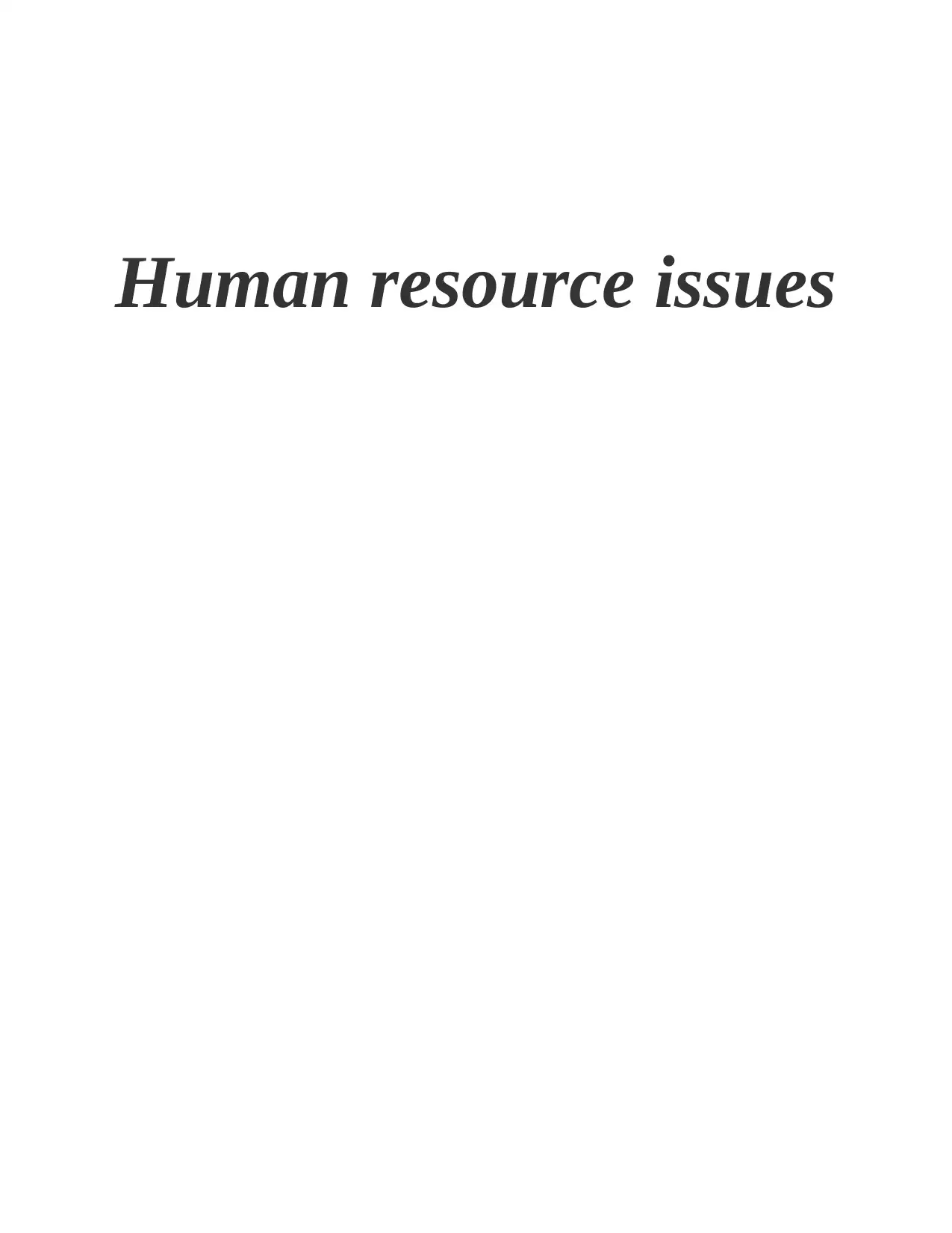
Human resource issues
Secure Best Marks with AI Grader
Need help grading? Try our AI Grader for instant feedback on your assignments.
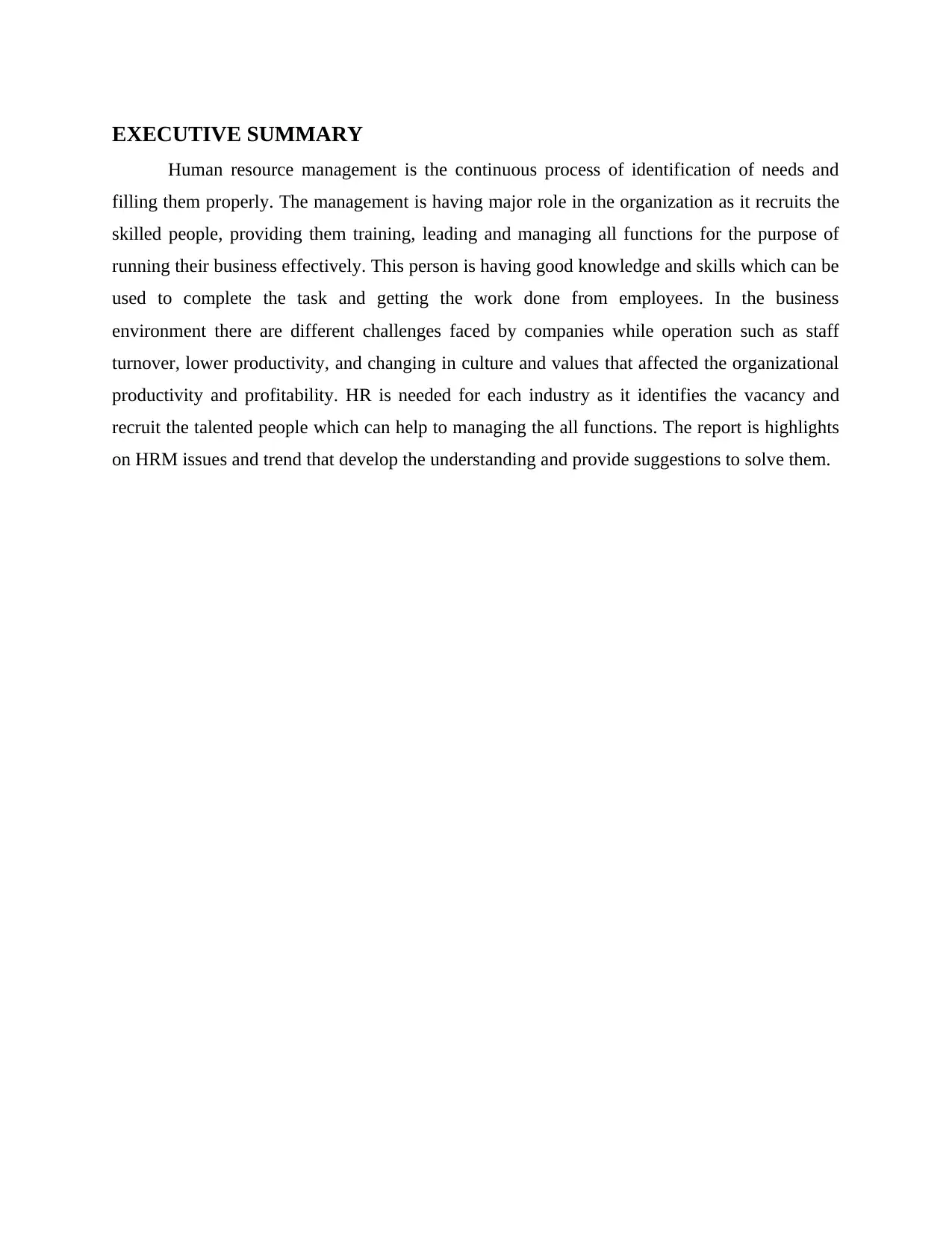
EXECUTIVE SUMMARY
Human resource management is the continuous process of identification of needs and
filling them properly. The management is having major role in the organization as it recruits the
skilled people, providing them training, leading and managing all functions for the purpose of
running their business effectively. This person is having good knowledge and skills which can be
used to complete the task and getting the work done from employees. In the business
environment there are different challenges faced by companies while operation such as staff
turnover, lower productivity, and changing in culture and values that affected the organizational
productivity and profitability. HR is needed for each industry as it identifies the vacancy and
recruit the talented people which can help to managing the all functions. The report is highlights
on HRM issues and trend that develop the understanding and provide suggestions to solve them.
Human resource management is the continuous process of identification of needs and
filling them properly. The management is having major role in the organization as it recruits the
skilled people, providing them training, leading and managing all functions for the purpose of
running their business effectively. This person is having good knowledge and skills which can be
used to complete the task and getting the work done from employees. In the business
environment there are different challenges faced by companies while operation such as staff
turnover, lower productivity, and changing in culture and values that affected the organizational
productivity and profitability. HR is needed for each industry as it identifies the vacancy and
recruit the talented people which can help to managing the all functions. The report is highlights
on HRM issues and trend that develop the understanding and provide suggestions to solve them.
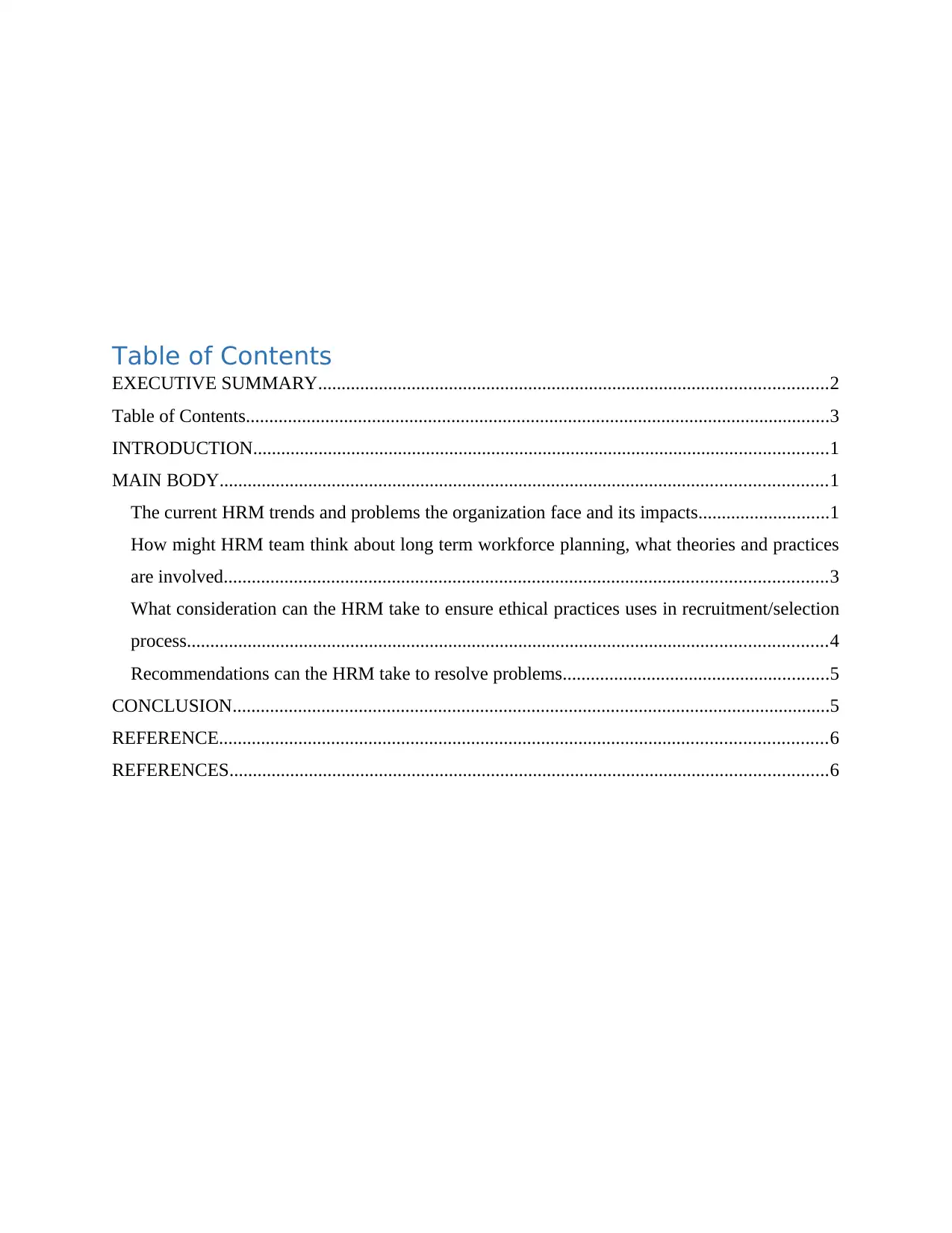
Table of Contents
EXECUTIVE SUMMARY.............................................................................................................2
Table of Contents.............................................................................................................................3
INTRODUCTION...........................................................................................................................1
MAIN BODY..................................................................................................................................1
The current HRM trends and problems the organization face and its impacts............................1
How might HRM team think about long term workforce planning, what theories and practices
are involved.................................................................................................................................3
What consideration can the HRM take to ensure ethical practices uses in recruitment/selection
process.........................................................................................................................................4
Recommendations can the HRM take to resolve problems.........................................................5
CONCLUSION................................................................................................................................5
REFERENCE..................................................................................................................................6
REFERENCES................................................................................................................................6
EXECUTIVE SUMMARY.............................................................................................................2
Table of Contents.............................................................................................................................3
INTRODUCTION...........................................................................................................................1
MAIN BODY..................................................................................................................................1
The current HRM trends and problems the organization face and its impacts............................1
How might HRM team think about long term workforce planning, what theories and practices
are involved.................................................................................................................................3
What consideration can the HRM take to ensure ethical practices uses in recruitment/selection
process.........................................................................................................................................4
Recommendations can the HRM take to resolve problems.........................................................5
CONCLUSION................................................................................................................................5
REFERENCE..................................................................................................................................6
REFERENCES................................................................................................................................6

Secure Best Marks with AI Grader
Need help grading? Try our AI Grader for instant feedback on your assignments.
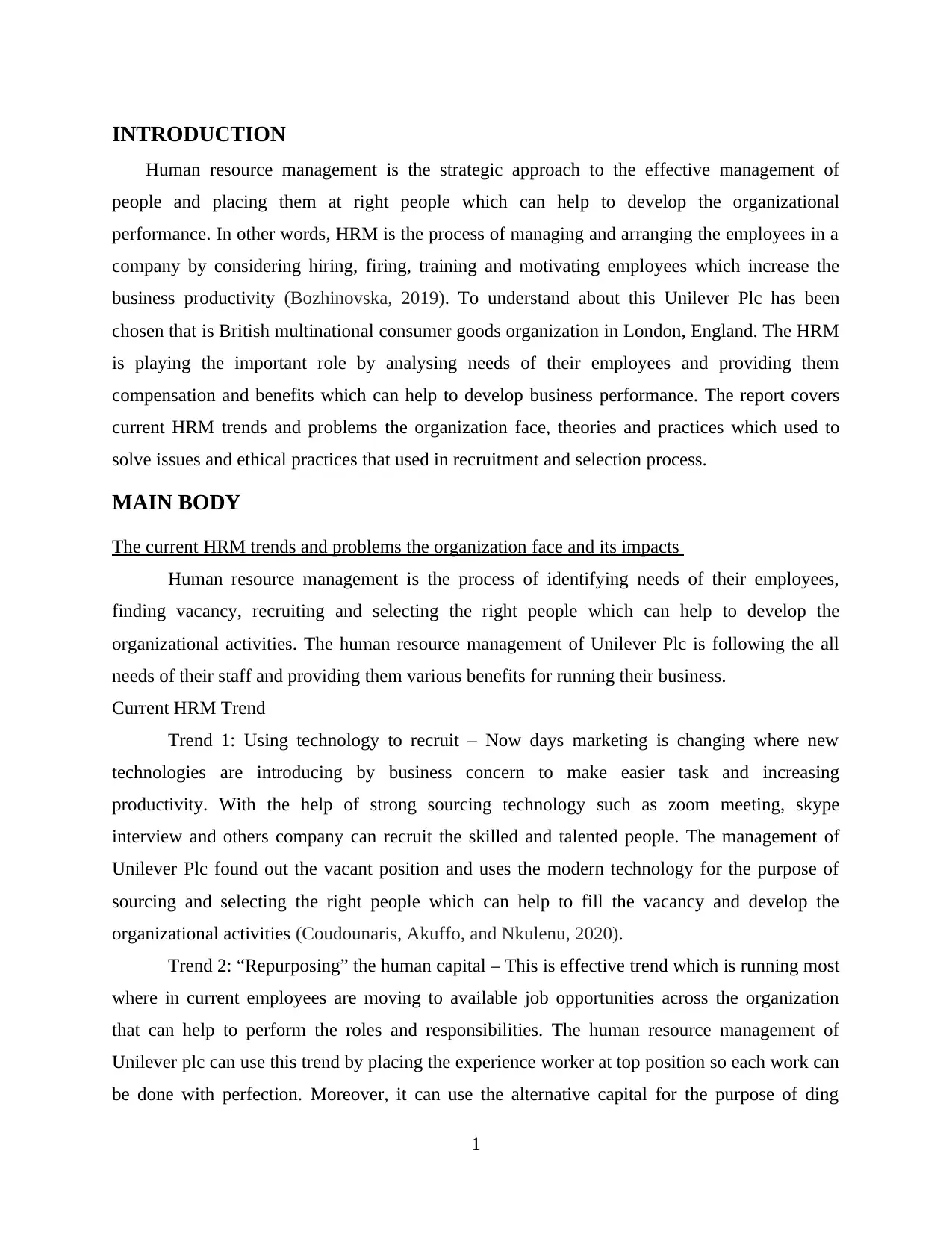
INTRODUCTION
Human resource management is the strategic approach to the effective management of
people and placing them at right people which can help to develop the organizational
performance. In other words, HRM is the process of managing and arranging the employees in a
company by considering hiring, firing, training and motivating employees which increase the
business productivity (Bozhinovska, 2019). To understand about this Unilever Plc has been
chosen that is British multinational consumer goods organization in London, England. The HRM
is playing the important role by analysing needs of their employees and providing them
compensation and benefits which can help to develop business performance. The report covers
current HRM trends and problems the organization face, theories and practices which used to
solve issues and ethical practices that used in recruitment and selection process.
MAIN BODY
The current HRM trends and problems the organization face and its impacts
Human resource management is the process of identifying needs of their employees,
finding vacancy, recruiting and selecting the right people which can help to develop the
organizational activities. The human resource management of Unilever Plc is following the all
needs of their staff and providing them various benefits for running their business.
Current HRM Trend
Trend 1: Using technology to recruit – Now days marketing is changing where new
technologies are introducing by business concern to make easier task and increasing
productivity. With the help of strong sourcing technology such as zoom meeting, skype
interview and others company can recruit the skilled and talented people. The management of
Unilever Plc found out the vacant position and uses the modern technology for the purpose of
sourcing and selecting the right people which can help to fill the vacancy and develop the
organizational activities (Coudounaris, Akuffo, and Nkulenu, 2020).
Trend 2: “Repurposing” the human capital – This is effective trend which is running most
where in current employees are moving to available job opportunities across the organization
that can help to perform the roles and responsibilities. The human resource management of
Unilever plc can use this trend by placing the experience worker at top position so each work can
be done with perfection. Moreover, it can use the alternative capital for the purpose of ding
1
Human resource management is the strategic approach to the effective management of
people and placing them at right people which can help to develop the organizational
performance. In other words, HRM is the process of managing and arranging the employees in a
company by considering hiring, firing, training and motivating employees which increase the
business productivity (Bozhinovska, 2019). To understand about this Unilever Plc has been
chosen that is British multinational consumer goods organization in London, England. The HRM
is playing the important role by analysing needs of their employees and providing them
compensation and benefits which can help to develop business performance. The report covers
current HRM trends and problems the organization face, theories and practices which used to
solve issues and ethical practices that used in recruitment and selection process.
MAIN BODY
The current HRM trends and problems the organization face and its impacts
Human resource management is the process of identifying needs of their employees,
finding vacancy, recruiting and selecting the right people which can help to develop the
organizational activities. The human resource management of Unilever Plc is following the all
needs of their staff and providing them various benefits for running their business.
Current HRM Trend
Trend 1: Using technology to recruit – Now days marketing is changing where new
technologies are introducing by business concern to make easier task and increasing
productivity. With the help of strong sourcing technology such as zoom meeting, skype
interview and others company can recruit the skilled and talented people. The management of
Unilever Plc found out the vacant position and uses the modern technology for the purpose of
sourcing and selecting the right people which can help to fill the vacancy and develop the
organizational activities (Coudounaris, Akuffo, and Nkulenu, 2020).
Trend 2: “Repurposing” the human capital – This is effective trend which is running most
where in current employees are moving to available job opportunities across the organization
that can help to perform the roles and responsibilities. The human resource management of
Unilever plc can use this trend by placing the experience worker at top position so each work can
be done with perfection. Moreover, it can use the alternative capital for the purpose of ding
1
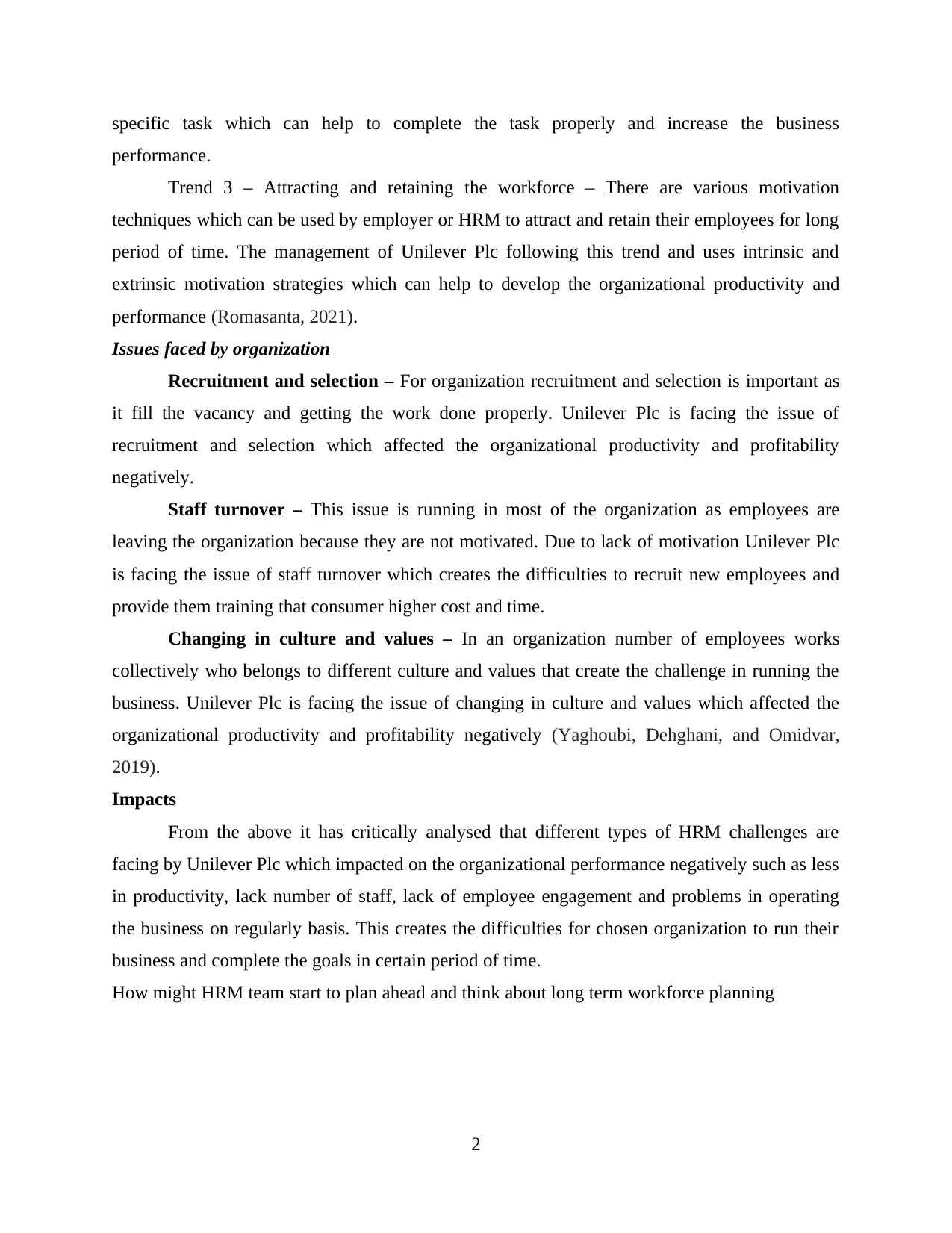
specific task which can help to complete the task properly and increase the business
performance.
Trend 3 – Attracting and retaining the workforce – There are various motivation
techniques which can be used by employer or HRM to attract and retain their employees for long
period of time. The management of Unilever Plc following this trend and uses intrinsic and
extrinsic motivation strategies which can help to develop the organizational productivity and
performance (Romasanta, 2021).
Issues faced by organization
Recruitment and selection – For organization recruitment and selection is important as
it fill the vacancy and getting the work done properly. Unilever Plc is facing the issue of
recruitment and selection which affected the organizational productivity and profitability
negatively.
Staff turnover – This issue is running in most of the organization as employees are
leaving the organization because they are not motivated. Due to lack of motivation Unilever Plc
is facing the issue of staff turnover which creates the difficulties to recruit new employees and
provide them training that consumer higher cost and time.
Changing in culture and values – In an organization number of employees works
collectively who belongs to different culture and values that create the challenge in running the
business. Unilever Plc is facing the issue of changing in culture and values which affected the
organizational productivity and profitability negatively (Yaghoubi, Dehghani, and Omidvar,
2019).
Impacts
From the above it has critically analysed that different types of HRM challenges are
facing by Unilever Plc which impacted on the organizational performance negatively such as less
in productivity, lack number of staff, lack of employee engagement and problems in operating
the business on regularly basis. This creates the difficulties for chosen organization to run their
business and complete the goals in certain period of time.
How might HRM team start to plan ahead and think about long term workforce planning
2
performance.
Trend 3 – Attracting and retaining the workforce – There are various motivation
techniques which can be used by employer or HRM to attract and retain their employees for long
period of time. The management of Unilever Plc following this trend and uses intrinsic and
extrinsic motivation strategies which can help to develop the organizational productivity and
performance (Romasanta, 2021).
Issues faced by organization
Recruitment and selection – For organization recruitment and selection is important as
it fill the vacancy and getting the work done properly. Unilever Plc is facing the issue of
recruitment and selection which affected the organizational productivity and profitability
negatively.
Staff turnover – This issue is running in most of the organization as employees are
leaving the organization because they are not motivated. Due to lack of motivation Unilever Plc
is facing the issue of staff turnover which creates the difficulties to recruit new employees and
provide them training that consumer higher cost and time.
Changing in culture and values – In an organization number of employees works
collectively who belongs to different culture and values that create the challenge in running the
business. Unilever Plc is facing the issue of changing in culture and values which affected the
organizational productivity and profitability negatively (Yaghoubi, Dehghani, and Omidvar,
2019).
Impacts
From the above it has critically analysed that different types of HRM challenges are
facing by Unilever Plc which impacted on the organizational performance negatively such as less
in productivity, lack number of staff, lack of employee engagement and problems in operating
the business on regularly basis. This creates the difficulties for chosen organization to run their
business and complete the goals in certain period of time.
How might HRM team start to plan ahead and think about long term workforce planning
2
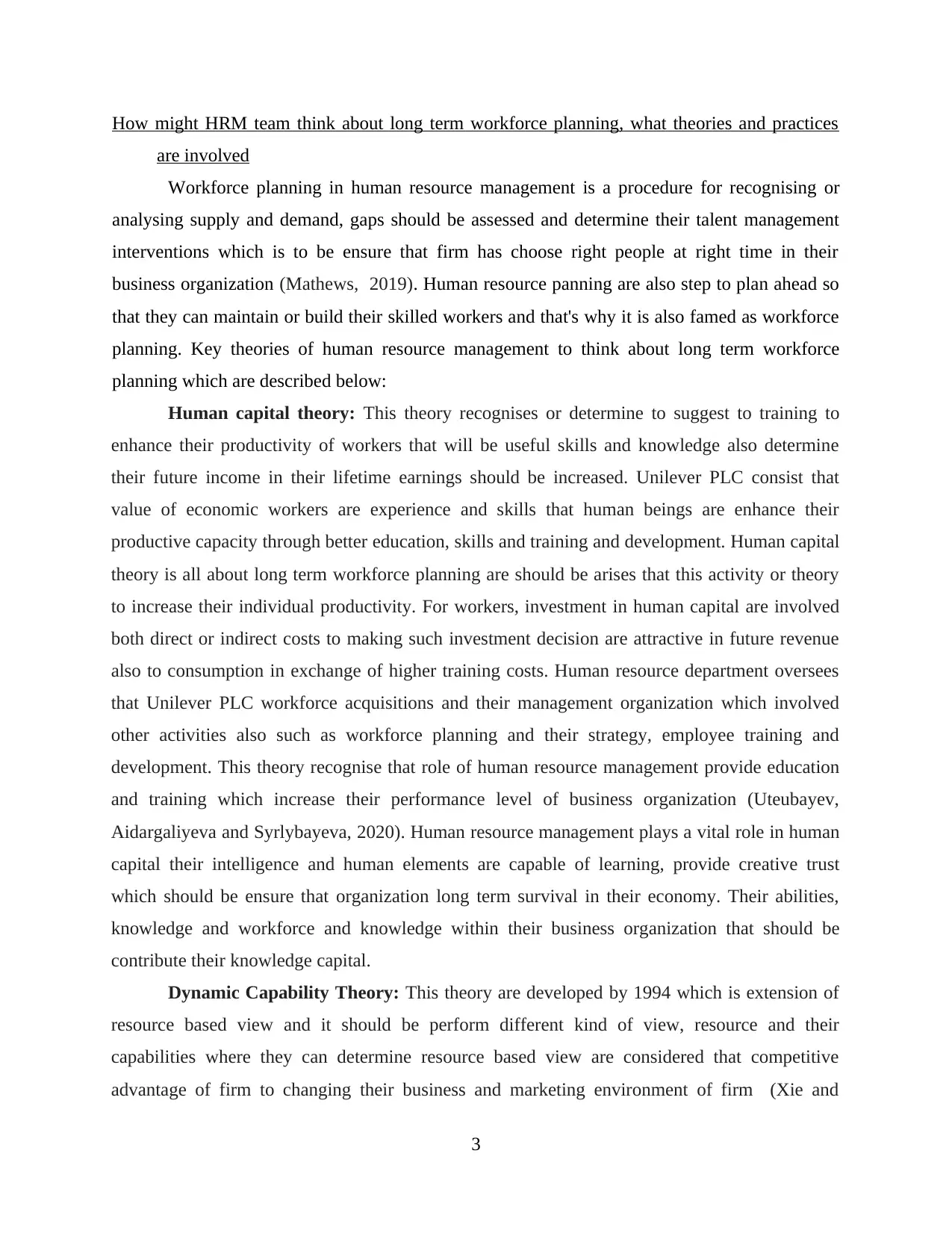
How might HRM team think about long term workforce planning, what theories and practices
are involved
Workforce planning in human resource management is a procedure for recognising or
analysing supply and demand, gaps should be assessed and determine their talent management
interventions which is to be ensure that firm has choose right people at right time in their
business organization (Mathews, 2019). Human resource panning are also step to plan ahead so
that they can maintain or build their skilled workers and that's why it is also famed as workforce
planning. Key theories of human resource management to think about long term workforce
planning which are described below:
Human capital theory: This theory recognises or determine to suggest to training to
enhance their productivity of workers that will be useful skills and knowledge also determine
their future income in their lifetime earnings should be increased. Unilever PLC consist that
value of economic workers are experience and skills that human beings are enhance their
productive capacity through better education, skills and training and development. Human capital
theory is all about long term workforce planning are should be arises that this activity or theory
to increase their individual productivity. For workers, investment in human capital are involved
both direct or indirect costs to making such investment decision are attractive in future revenue
also to consumption in exchange of higher training costs. Human resource department oversees
that Unilever PLC workforce acquisitions and their management organization which involved
other activities also such as workforce planning and their strategy, employee training and
development. This theory recognise that role of human resource management provide education
and training which increase their performance level of business organization (Uteubayev,
Aidargaliyeva and Syrlybayeva, 2020). Human resource management plays a vital role in human
capital their intelligence and human elements are capable of learning, provide creative trust
which should be ensure that organization long term survival in their economy. Their abilities,
knowledge and workforce and knowledge within their business organization that should be
contribute their knowledge capital.
Dynamic Capability Theory: This theory are developed by 1994 which is extension of
resource based view and it should be perform different kind of view, resource and their
capabilities where they can determine resource based view are considered that competitive
advantage of firm to changing their business and marketing environment of firm (Xie and
3
are involved
Workforce planning in human resource management is a procedure for recognising or
analysing supply and demand, gaps should be assessed and determine their talent management
interventions which is to be ensure that firm has choose right people at right time in their
business organization (Mathews, 2019). Human resource panning are also step to plan ahead so
that they can maintain or build their skilled workers and that's why it is also famed as workforce
planning. Key theories of human resource management to think about long term workforce
planning which are described below:
Human capital theory: This theory recognises or determine to suggest to training to
enhance their productivity of workers that will be useful skills and knowledge also determine
their future income in their lifetime earnings should be increased. Unilever PLC consist that
value of economic workers are experience and skills that human beings are enhance their
productive capacity through better education, skills and training and development. Human capital
theory is all about long term workforce planning are should be arises that this activity or theory
to increase their individual productivity. For workers, investment in human capital are involved
both direct or indirect costs to making such investment decision are attractive in future revenue
also to consumption in exchange of higher training costs. Human resource department oversees
that Unilever PLC workforce acquisitions and their management organization which involved
other activities also such as workforce planning and their strategy, employee training and
development. This theory recognise that role of human resource management provide education
and training which increase their performance level of business organization (Uteubayev,
Aidargaliyeva and Syrlybayeva, 2020). Human resource management plays a vital role in human
capital their intelligence and human elements are capable of learning, provide creative trust
which should be ensure that organization long term survival in their economy. Their abilities,
knowledge and workforce and knowledge within their business organization that should be
contribute their knowledge capital.
Dynamic Capability Theory: This theory are developed by 1994 which is extension of
resource based view and it should be perform different kind of view, resource and their
capabilities where they can determine resource based view are considered that competitive
advantage of firm to changing their business and marketing environment of firm (Xie and
3
Paraphrase This Document
Need a fresh take? Get an instant paraphrase of this document with our AI Paraphraser
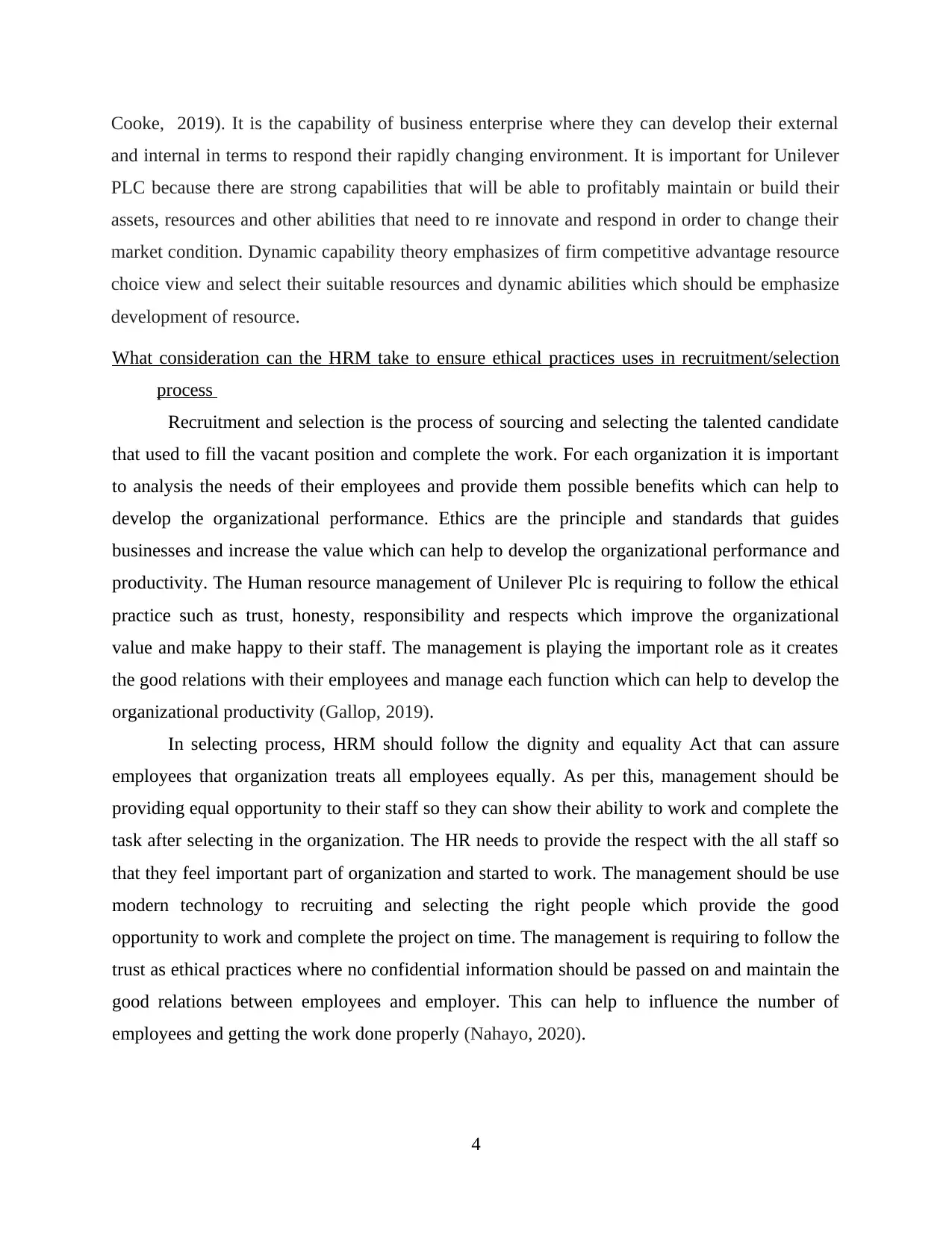
Cooke, 2019). It is the capability of business enterprise where they can develop their external
and internal in terms to respond their rapidly changing environment. It is important for Unilever
PLC because there are strong capabilities that will be able to profitably maintain or build their
assets, resources and other abilities that need to re innovate and respond in order to change their
market condition. Dynamic capability theory emphasizes of firm competitive advantage resource
choice view and select their suitable resources and dynamic abilities which should be emphasize
development of resource.
What consideration can the HRM take to ensure ethical practices uses in recruitment/selection
process
Recruitment and selection is the process of sourcing and selecting the talented candidate
that used to fill the vacant position and complete the work. For each organization it is important
to analysis the needs of their employees and provide them possible benefits which can help to
develop the organizational performance. Ethics are the principle and standards that guides
businesses and increase the value which can help to develop the organizational performance and
productivity. The Human resource management of Unilever Plc is requiring to follow the ethical
practice such as trust, honesty, responsibility and respects which improve the organizational
value and make happy to their staff. The management is playing the important role as it creates
the good relations with their employees and manage each function which can help to develop the
organizational productivity (Gallop, 2019).
In selecting process, HRM should follow the dignity and equality Act that can assure
employees that organization treats all employees equally. As per this, management should be
providing equal opportunity to their staff so they can show their ability to work and complete the
task after selecting in the organization. The HR needs to provide the respect with the all staff so
that they feel important part of organization and started to work. The management should be use
modern technology to recruiting and selecting the right people which provide the good
opportunity to work and complete the project on time. The management is requiring to follow the
trust as ethical practices where no confidential information should be passed on and maintain the
good relations between employees and employer. This can help to influence the number of
employees and getting the work done properly (Nahayo, 2020).
4
and internal in terms to respond their rapidly changing environment. It is important for Unilever
PLC because there are strong capabilities that will be able to profitably maintain or build their
assets, resources and other abilities that need to re innovate and respond in order to change their
market condition. Dynamic capability theory emphasizes of firm competitive advantage resource
choice view and select their suitable resources and dynamic abilities which should be emphasize
development of resource.
What consideration can the HRM take to ensure ethical practices uses in recruitment/selection
process
Recruitment and selection is the process of sourcing and selecting the talented candidate
that used to fill the vacant position and complete the work. For each organization it is important
to analysis the needs of their employees and provide them possible benefits which can help to
develop the organizational performance. Ethics are the principle and standards that guides
businesses and increase the value which can help to develop the organizational performance and
productivity. The Human resource management of Unilever Plc is requiring to follow the ethical
practice such as trust, honesty, responsibility and respects which improve the organizational
value and make happy to their staff. The management is playing the important role as it creates
the good relations with their employees and manage each function which can help to develop the
organizational productivity (Gallop, 2019).
In selecting process, HRM should follow the dignity and equality Act that can assure
employees that organization treats all employees equally. As per this, management should be
providing equal opportunity to their staff so they can show their ability to work and complete the
task after selecting in the organization. The HR needs to provide the respect with the all staff so
that they feel important part of organization and started to work. The management should be use
modern technology to recruiting and selecting the right people which provide the good
opportunity to work and complete the project on time. The management is requiring to follow the
trust as ethical practices where no confidential information should be passed on and maintain the
good relations between employees and employer. This can help to influence the number of
employees and getting the work done properly (Nahayo, 2020).
4
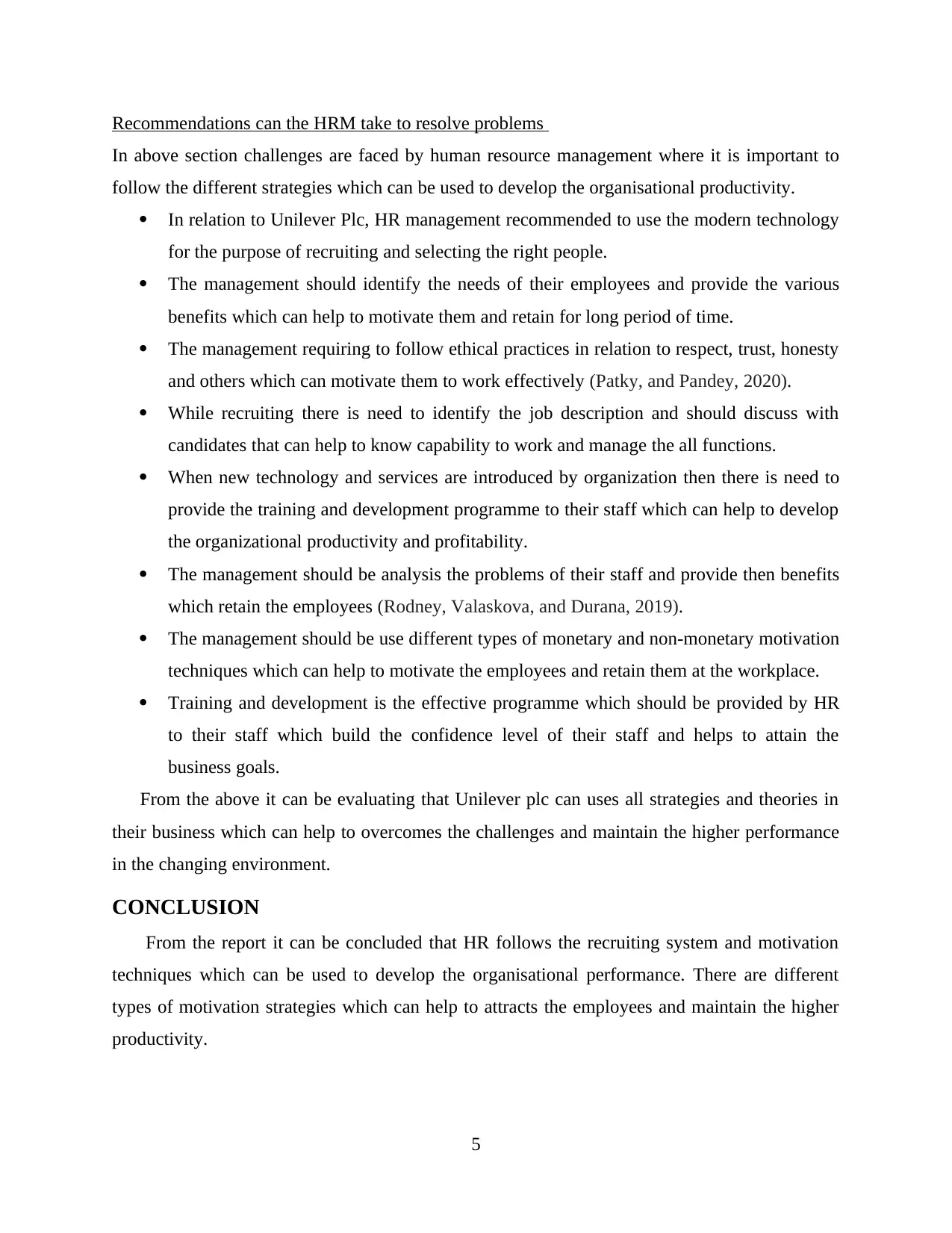
Recommendations can the HRM take to resolve problems
In above section challenges are faced by human resource management where it is important to
follow the different strategies which can be used to develop the organisational productivity.
In relation to Unilever Plc, HR management recommended to use the modern technology
for the purpose of recruiting and selecting the right people.
The management should identify the needs of their employees and provide the various
benefits which can help to motivate them and retain for long period of time.
The management requiring to follow ethical practices in relation to respect, trust, honesty
and others which can motivate them to work effectively (Patky, and Pandey, 2020).
While recruiting there is need to identify the job description and should discuss with
candidates that can help to know capability to work and manage the all functions.
When new technology and services are introduced by organization then there is need to
provide the training and development programme to their staff which can help to develop
the organizational productivity and profitability.
The management should be analysis the problems of their staff and provide then benefits
which retain the employees (Rodney, Valaskova, and Durana, 2019).
The management should be use different types of monetary and non-monetary motivation
techniques which can help to motivate the employees and retain them at the workplace.
Training and development is the effective programme which should be provided by HR
to their staff which build the confidence level of their staff and helps to attain the
business goals.
From the above it can be evaluating that Unilever plc can uses all strategies and theories in
their business which can help to overcomes the challenges and maintain the higher performance
in the changing environment.
CONCLUSION
From the report it can be concluded that HR follows the recruiting system and motivation
techniques which can be used to develop the organisational performance. There are different
types of motivation strategies which can help to attracts the employees and maintain the higher
productivity.
5
In above section challenges are faced by human resource management where it is important to
follow the different strategies which can be used to develop the organisational productivity.
In relation to Unilever Plc, HR management recommended to use the modern technology
for the purpose of recruiting and selecting the right people.
The management should identify the needs of their employees and provide the various
benefits which can help to motivate them and retain for long period of time.
The management requiring to follow ethical practices in relation to respect, trust, honesty
and others which can motivate them to work effectively (Patky, and Pandey, 2020).
While recruiting there is need to identify the job description and should discuss with
candidates that can help to know capability to work and manage the all functions.
When new technology and services are introduced by organization then there is need to
provide the training and development programme to their staff which can help to develop
the organizational productivity and profitability.
The management should be analysis the problems of their staff and provide then benefits
which retain the employees (Rodney, Valaskova, and Durana, 2019).
The management should be use different types of monetary and non-monetary motivation
techniques which can help to motivate the employees and retain them at the workplace.
Training and development is the effective programme which should be provided by HR
to their staff which build the confidence level of their staff and helps to attain the
business goals.
From the above it can be evaluating that Unilever plc can uses all strategies and theories in
their business which can help to overcomes the challenges and maintain the higher performance
in the changing environment.
CONCLUSION
From the report it can be concluded that HR follows the recruiting system and motivation
techniques which can be used to develop the organisational performance. There are different
types of motivation strategies which can help to attracts the employees and maintain the higher
productivity.
5
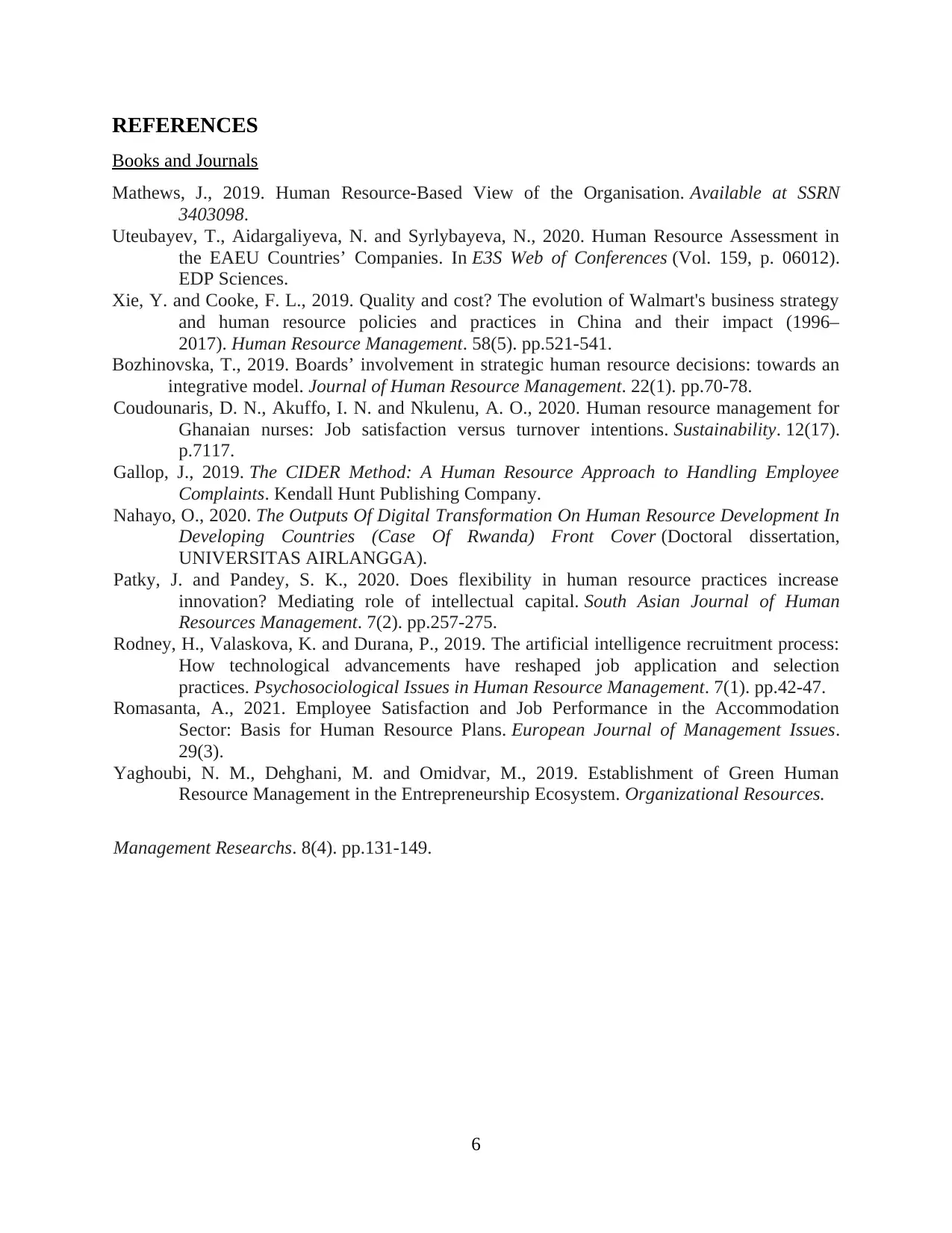
REFERENCES
Books and Journals
Mathews, J., 2019. Human Resource-Based View of the Organisation. Available at SSRN
3403098.
Uteubayev, T., Aidargaliyeva, N. and Syrlybayeva, N., 2020. Human Resource Assessment in
the EAEU Countries’ Companies. In E3S Web of Conferences (Vol. 159, p. 06012).
EDP Sciences.
Xie, Y. and Cooke, F. L., 2019. Quality and cost? The evolution of Walmart's business strategy
and human resource policies and practices in China and their impact (1996–
2017). Human Resource Management. 58(5). pp.521-541.
Bozhinovska, T., 2019. Boards’ involvement in strategic human resource decisions: towards an
integrative model. Journal of Human Resource Management. 22(1). pp.70-78.
Coudounaris, D. N., Akuffo, I. N. and Nkulenu, A. O., 2020. Human resource management for
Ghanaian nurses: Job satisfaction versus turnover intentions. Sustainability. 12(17).
p.7117.
Gallop, J., 2019. The CIDER Method: A Human Resource Approach to Handling Employee
Complaints. Kendall Hunt Publishing Company.
Nahayo, O., 2020. The Outputs Of Digital Transformation On Human Resource Development In
Developing Countries (Case Of Rwanda) Front Cover (Doctoral dissertation,
UNIVERSITAS AIRLANGGA).
Patky, J. and Pandey, S. K., 2020. Does flexibility in human resource practices increase
innovation? Mediating role of intellectual capital. South Asian Journal of Human
Resources Management. 7(2). pp.257-275.
Rodney, H., Valaskova, K. and Durana, P., 2019. The artificial intelligence recruitment process:
How technological advancements have reshaped job application and selection
practices. Psychosociological Issues in Human Resource Management. 7(1). pp.42-47.
Romasanta, A., 2021. Employee Satisfaction and Job Performance in the Accommodation
Sector: Basis for Human Resource Plans. European Journal of Management Issues.
29(3).
Yaghoubi, N. M., Dehghani, M. and Omidvar, M., 2019. Establishment of Green Human
Resource Management in the Entrepreneurship Ecosystem. Organizational Resources.
Management Researchs. 8(4). pp.131-149.
6
Books and Journals
Mathews, J., 2019. Human Resource-Based View of the Organisation. Available at SSRN
3403098.
Uteubayev, T., Aidargaliyeva, N. and Syrlybayeva, N., 2020. Human Resource Assessment in
the EAEU Countries’ Companies. In E3S Web of Conferences (Vol. 159, p. 06012).
EDP Sciences.
Xie, Y. and Cooke, F. L., 2019. Quality and cost? The evolution of Walmart's business strategy
and human resource policies and practices in China and their impact (1996–
2017). Human Resource Management. 58(5). pp.521-541.
Bozhinovska, T., 2019. Boards’ involvement in strategic human resource decisions: towards an
integrative model. Journal of Human Resource Management. 22(1). pp.70-78.
Coudounaris, D. N., Akuffo, I. N. and Nkulenu, A. O., 2020. Human resource management for
Ghanaian nurses: Job satisfaction versus turnover intentions. Sustainability. 12(17).
p.7117.
Gallop, J., 2019. The CIDER Method: A Human Resource Approach to Handling Employee
Complaints. Kendall Hunt Publishing Company.
Nahayo, O., 2020. The Outputs Of Digital Transformation On Human Resource Development In
Developing Countries (Case Of Rwanda) Front Cover (Doctoral dissertation,
UNIVERSITAS AIRLANGGA).
Patky, J. and Pandey, S. K., 2020. Does flexibility in human resource practices increase
innovation? Mediating role of intellectual capital. South Asian Journal of Human
Resources Management. 7(2). pp.257-275.
Rodney, H., Valaskova, K. and Durana, P., 2019. The artificial intelligence recruitment process:
How technological advancements have reshaped job application and selection
practices. Psychosociological Issues in Human Resource Management. 7(1). pp.42-47.
Romasanta, A., 2021. Employee Satisfaction and Job Performance in the Accommodation
Sector: Basis for Human Resource Plans. European Journal of Management Issues.
29(3).
Yaghoubi, N. M., Dehghani, M. and Omidvar, M., 2019. Establishment of Green Human
Resource Management in the Entrepreneurship Ecosystem. Organizational Resources.
Management Researchs. 8(4). pp.131-149.
6
1 out of 10
Related Documents
Your All-in-One AI-Powered Toolkit for Academic Success.
+13062052269
info@desklib.com
Available 24*7 on WhatsApp / Email
![[object Object]](/_next/static/media/star-bottom.7253800d.svg)
Unlock your academic potential
© 2024 | Zucol Services PVT LTD | All rights reserved.





